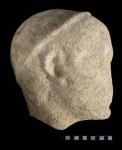 On January 13 of this year, the Italian Guardia di Finanza, a police that focuses on financial crimes and smuggling, stopped a truck in Ostia Antica, the ancient port town just south of Rome, and found pieces of an ancient statue of colossal dimension (an estimated 2.5 meters, over 8 feet, high) hidden under rubble. Although the pieces were incomplete, you could identify a larger-than-life togate male figure seated on an elaborately decorated throne with his left foot forward. The foot is wearing a “caliga,” the hobnailed lightweight boot of the Roman legionary.
On January 13 of this year, the Italian Guardia di Finanza, a police that focuses on financial crimes and smuggling, stopped a truck in Ostia Antica, the ancient port town just south of Rome, and found pieces of an ancient statue of colossal dimension (an estimated 2.5 meters, over 8 feet, high) hidden under rubble. Although the pieces were incomplete, you could identify a larger-than-life togate male figure seated on an elaborately decorated throne with his left foot forward. The foot is wearing a “caliga,” the hobnailed lightweight boot of the Roman legionary.
 The looters had broken the statue into smaller, more manageable pieces and were headed to a warehouse nearby. From there the pieces would probably have been smuggled into Switzerland. Two men were arrested and they revealed the excavation place where the statue had been unearthed by looters: the countryside of Lake Nemi, the lake where Emperor Caligula’s gigantic floating palace pleasure barges were found.
The looters had broken the statue into smaller, more manageable pieces and were headed to a warehouse nearby. From there the pieces would probably have been smuggled into Switzerland. Two men were arrested and they revealed the excavation place where the statue had been unearthed by looters: the countryside of Lake Nemi, the lake where Emperor Caligula’s gigantic floating palace pleasure barges were found.
The Ministry for Cultural Heritage had the area sealed off and deployed an archaeological team to excavate the exact spot where the looters had discovered the statue. Excavations began on April 11th and immediately returned the vestiges of a large thermal complex, probably a nympheum, a large water monument dedicated to the nymphs. It had a fan-shaped floor plan surrounded by a colonnade that would have been 23 feet high in its day.
At first they thought it might be a mausoleum just because colossal statues like the one discovered there weren’t usually kept in a nymphaea, not even the private ones of the ruling class, but then they found pools with glass mosaic floors, a vast hydraulic system and a lead stamp with the name “Gaius Julius Silanus,” a family of prominence during the 1st century A.D. who had ties to the Julio-Claudian dynasty.
 Archaeologists also found over one hundred fragments of the colossal statue. The scepter held in the left hand, drapery on the left shoulder, what might have been a round globe held in the figure’s right hand, pieces of the pedestal, and most excitingly, the head. The back of the head was unsculpted suggesting the statue was meant for a niche in the grotto. The head had been decapitated from the statue in antiquity and defaced. You can barely make out features, certainly not enough to say it’s Caligula for sure, but there’s definitely a diadem, and a where there’s a diadem there’s a deity or deified royalty. The fact that the statue was defaced, decapitated and toppled over in antiquity also supports it being a Caligula effigy. The identification is thoroughly speculative, though, no matter what the headlines say.
Archaeologists also found over one hundred fragments of the colossal statue. The scepter held in the left hand, drapery on the left shoulder, what might have been a round globe held in the figure’s right hand, pieces of the pedestal, and most excitingly, the head. The back of the head was unsculpted suggesting the statue was meant for a niche in the grotto. The head had been decapitated from the statue in antiquity and defaced. You can barely make out features, certainly not enough to say it’s Caligula for sure, but there’s definitely a diadem, and a where there’s a diadem there’s a deity or deified royalty. The fact that the statue was defaced, decapitated and toppled over in antiquity also supports it being a Caligula effigy. The identification is thoroughly speculative, though, no matter what the headlines say.
The statue has had a preliminary cleaning so it could be displayed at the press conference yesterday. It will remain in Rome for the time being, where it is being restored in the laboratories of the Palazzo Massimo. Once the colossus is ready to move, he will be returned to Nemi for permanently study and display at the Museo delle Navi Romane, the museum built by Mussolini to host Caligula’s ships. There are more pictures in this La Repubblica slideshow, and footage of the statue and excavation from the Guarda di Finanzia below.
[kml_flashembed movie="http://www.youtube.com/v/OsgW3yLl71M" width="425" height="350" wmode="transparent" /]